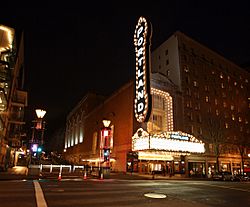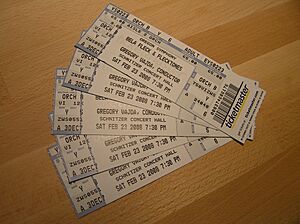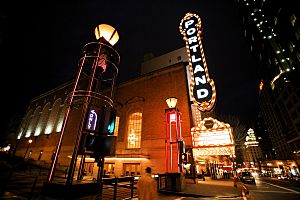Arlene Schnitzer Concert Hall facts for kids

Exterior of venue seen from Broadway (c. 2007)
|
|
| Former names | Portland Publix Theatre (1928–30) Paramount Theatre (1930–84) |
|---|---|
| Address | 1037 SW Broadway Portland, OR 97205-3004 |
| Location | Downtown Portland |
| Owner | City of Portland |
| Operator | Portland's Centers for the Arts |
| Capacity | 2,776 |
| Construction | |
| Opened | March 8, 1928 |
| Closed | 1982 |
| Reopened | September 8, 1984 |
| Construction cost | $1.5 million ($25.3 million in 2022 dollars ) |
| Architect | Rapp and Rapp |
|
Paramount Theatre
|
|
| Architectural style | Italian Rococo Revival |
| NRHP reference No. | 76001585 |
| Added to NRHP | April 22, 1976 |
The Arlene Schnitzer Concert Hall is a famous theater and performing arts center in Portland, Oregon, United States. It's often called "The Schnitz" by locals. This building is part of the Portland Center for the Performing Arts. It is home to the Oregon Symphony, Portland Youth Philharmonic, and other groups. It also hosts concerts and movies.
This building is the last big theater left on Broadway in Portland. This street used to have many large and grand theaters.
Contents
About the Schnitz
The Arlene Schnitzer Concert Hall is a large venue. It has:
- Seating for 2,776 people. This includes seats on the main floor and in the upper balcony.
- Dressing rooms for up to 90 performers.
- A special portable shell that helps with sound.
- Entrances on Broadway and Main Street.
History of the Building
The building was designed by a famous architecture firm called Rapp and Rapp. They were known for designing many theaters. When it opened, it was considered the biggest and most fancy theater in Portland.
From Movie Palace to Concert Hall
The theater first opened in March 1928 as the Portland Publix Theatre. It was a place for live shows called vaudeville. In 1930, its name changed to the Paramount Theater. This was because the owners had a deal to show Paramount movies. The building showed films until 1972, then it started hosting concerts.
When you visited, a huge 65-foot (20 m) tall "Portland" sign lit up the Broadway entrance. It had about 6,000 lights! In 1930, the sign changed to "Paramount." It stayed that way until 1984, when it was changed back to "Portland."
The theater had many fancy lobbies and hallways. The main entrance had large windows with velvet drapes. The walls were covered with mirrors and marble. The floors had expensive carpets. Some furniture was even bought from a French museum! The snack counter was made of marble and was very long. People called it the "longest candy counter in the West."
The lobby had huge crystal chandeliers. The biggest one was nearly 8 feet (2.4 m) wide and weighed over 1,700 pounds (770 kg). It had 181 lights! Today, the largest chandelier has 137 bulbs.
The top row of balcony seats was six stories above the stage. There were special lounges for men and women. The men's lounge had fireplaces and phones. The women's lounge had dressing tables and hairdressers. There was even a self-playing piano in the lobby.
The auditorium walls were decorated with beautiful murals. Near the stage, small balconies hid the pipes of a large Wurlitzer organ. This organ could be raised to the stage level with a button.
Newspaper ads once said the theater had 4,000 seats, calling it "An acre of seats." But it actually had about 3,000 seats.
The ceilings were special. Panels hung from the roof, creating a hidden space for lights. These lights glowed indirectly, making the room feel open and spacious.
The orchestra pit could hold 30 musicians. There was also a "flying" stage that could move up, down, or around above the main stage.
In 1928, a photo of the theater was on the front page of The Oregonian newspaper. This was because of an unusual event involving a young man named Robert Nolan. He saw himself in a movie playing at the theater. While there, he saw people carrying the day's money. He then took $1,176 from the box office. He was caught later, having spent almost all the money.
During the Great Depression, the theater tried to attract more people. They hired musicians and a "psychic" to entertain in the lobby. Admission was 50 cents then, down from 60 cents on opening night.
By 1936, the theater was sold to the Evergreen chain. They owned many movie theaters in Portland.
Over the years, the building started to show its age. In 1965, a piece of the balcony fell off. In 1970, large blocks of stone fell from the building's outside. The owners were not spending money to fix it. In 1971, John Haviland bought the theater. He then leased it to Tom Moyer, who owned a chain of theaters.
Becoming a Concert Venue
John Haviland thought it was too expensive to run a 3,000-seat movie theater with television becoming popular. On August 15, 1972, the last regular movie was shown.
In 1972, a group called Paramount Northwest leased the theater. They started promoting live concerts. Famous bands like Heart, Tom Petty, and Elvis Costello played there. Tickets were sometimes as low as 92 cents!
Haviland wanted to make more money from the theater. He felt that the young people attending rock concerts were not spending enough and were damaging the theater. He won a court case to stop Paramount Northwest from renewing their lease. Haviland wanted to fix up the theater and offer more upscale entertainment.
In August 1976, the Paramount Theatre was sold to West Coast Theatres. In 1980, the owner offered to sell it to the city for $4 million. The city council discussed whether to fix up the old theater or build a new one.
In 1982, the City of Portland decided to buy the theater. But talks broke down. The city council then voted to take over the building. A jury decided the city had to pay the owner $4.1 million for it.
The theater cost $500,000 to build in 1928. Today, it is valued at over $32 million.
Restoration and New Name
In 1972, the Portland City Council decided the building was a "Landmark." This meant its outside could not be changed easily. In 1976, the building was added to the National Register of Historic Places.
A big renovation started in September 1983. The goal was to bring back the building's original beauty. The inside of the main hall was painted a single color, but the old murals were not put back. Arlene and Harold Schnitzer, who lived in Portland, gave a lot of money to help with the project. The renovation cost $10 million and took one year. It fixed up the theater's fancy interior and made it safe and comfortable for today's audiences.
The famous 65-foot-tall "Paramount" sign was taken down in March 1984. A new sign was made to look like the original "Portland" sign from 1928. This new sign, with neon letters five feet tall, was put up on September 4, 1984. The theater reopened later that month.
Today, the concert hall hosts many different shows. These include classical music, jazz, pop, rock, folk, and gospel music. It also has dance shows, plays, travel films, conferences, and even weddings.
The concert hall features:
- Seating for 2,776 people on the main floor and balcony.
- A stage that is 94 × 32-foot (9.8 m) with a traditional proscenium arch.
- An orchestra pit for 15 musicians and a choir loft.
- Dressing rooms for 90 performers.
- A portable, flexible shell to improve sound.
The design highlights include wool carpets made in New Zealand. The original chandeliers were fixed and given new crystals. The fancy interior was repaired and replaced. The new colors are warm neutrals and teal, replacing the original dark gold, green, and rose.
When the performing arts center opened in 1984, the Portland Theatre building was named after Arlene Schnitzer.
The original theater organ and statues were sold in an auction in March 1975. During the auction, people wanted to keep a marble statue called "Surprise." It showed a girl with her hands over her face. The audience collected money, raising $5,233.97 to buy the statue and keep it in the lobby. The statue has a missing finger from a bullet during a box-office robbery in the 1950s.
Famous Performances
Many famous people have performed at the Arlene Schnitzer Concert Hall:
- Eugene Pallette (May 1930)
- Stepin Fetchit (May 28 - June 3, 1931)
- Anita Page (September 2, 1931)
- Betty Compson (March 3–9, 1932)
- Blanche Sweet (August 18–24, 1932)
- Conchita Montenegro (September 29 - October 5, 1932)
- The Marx Brothers (May 1–7, 1935)
- Grace Moore (April 1939)
- Ronald Reagan and Donald Crisp (October 19, 1940)
- The Andrews Sisters (May 30 - June 5, 1946)
- Betty Hutton (January 1953)
- Louis Armstrong (February 1954)
- Frank Sinatra (June 7, 1957)
- Harry Belafonte (June 1957)
- Buddy Holly, Chuck Berry, The Everly Brothers, and Fats Domino (October 22, 1957)
- Sam Cooke, The Everly Brothers, Paul Anka, and Frankie Avalon (May 14, 1958)
- Maurice Chevalier (June 1958)
- Louis Armstrong (September 1959)
- Vincent Price (October 1959)
- Liberace (May 29, 1962)
- Joan Baez (March 1964)
- Bob Dylan (March 1966, January and December 1980, August 1990, June 1995, May 2022)
- Grateful Dead (July 1972, June 1976, October 1977)
- George Carlin (March 9, 1973)
- Stevie Wonder (March 10, 1973)
- Don Ameche (June 1973)
- Fleetwood Mac (November 1974, August 1975)
- Jerry Garcia Band (March 1975, October 1978)
- Frank Zappa (October 1975, March and October 1980)
- Bruce Springsteen (October 25, 1975, December 19, 1978, October 28, 1996)
- Rain: A Tribute to the Beatles (June 7, 1976)
- Rush (October 1976, September 1977)
- Billy Joel (February and October, 1977)
- Queen (March 12, 1977)
- Genesis (April 1, 1977)
- Iggy Pop with David Bowie on piano and backing vocals (April 4 and 5, 1977)
- Jimmy Buffett (June 4, 1977)
- Hall & Oates (October 22, 1977)
- Elvis Costello (February 1978, February 1979)
- Patti Smith (May 5, 1978)
- Bob Marley and the Wailers (July 16, 1978)
- Talking Heads (September 9, 1978)
- ABBA (September 18, 1979)
- Tom Petty and the Heartbreakers (December 1979, April 1983)
- The Police (February 5, 1980)
- The Allman Brothers Band (September 19, 1981)
- Def Leppard (November 4, 1981)
- The Go-Go's (August 23, 1982)
- Heart (December 29, 1982)
- U2 (May 27, 1983)
- The Cure (October 23, 1984)
- Madonna (April 1985)
- Leonard Cohen (October 1988)
- Roy Orbison (October 1988)
- Phish (August 26, 1993)
- Tori Amos (July 1996, December 2007, November 2017)
- Ringo Starr & His All-Starr Band (April 1997)
- Neil Young (March 1999)
- Oasis (April 2000)
- Coldplay (June 2001)
- Prince (April 2002)
- Mariah Carey (December 9, 2003)
- Kelly Clarkson (May 28, 2005)
- Brian Wilson (August 2005, October 2016)
- Pearl Jam (July 20, 2006)
- Tenacious D (February 19th, 2007)
- Bill Clinton (April 20, 2007)
- Arcade Fire (May 27, 2007)
- The Decemberists (February 19, 2011)
- Fiona Apple (July 26, 2012)
- Robin Williams (January 11, 2013)
- Soundgarden (February 14, 2013)
- The Monkees (August 18, 2014)
- Pixies (February 19, 2014)
- Steely Dan (July 24, 2014)
- Ryan Adams (October 5, 2014)
- Wilco (September 4, 2016)
- The National (November 27, 2017)
- Hillary Clinton (October 21, 2024)
See also
- List of concert halls
- Portland sign




